Spider webs are some of the most amazing feats of engineering in the animal kingdom. Through evolution and biological programming, spiders have learned how to make extremely effective webs.
Seeing a spider web in or near your house may raise some red flags. You may be wondering what kind of spider makes that kind of web, and if you should be concerned and take pest control action.
Or, you may just be curious about the different types of spider webs out there, as some seem to be very different from others. Regardless, this post will tell you everything that you need to know.
Table of Contents
How Many Types Of Spider Webs Are There?
There aren’t any scientific resources that explicitly state how many different types of spider webs exist. However, virtually all types of webs have been documented and studied to some extent.
It’s from this research that we can determine that there are six main types of spider webs, with three addition types of webs that serve unique purposes.
Some of these webs are extremely common, while others are only made by a few different genus or species of spiders. So, it may be a treat to see some of these webs in the wild!
There are 9 types of webs that spiders produce:
- Orb Web
- Tangle Web / Cobweb
- Funnel Web
- Sheet Web
- Triangle Web
- Mesh Web
- Sperm Web
- Molt Mat
- Egg Sac
6 Primary Types Of Spider Webs
There are six main types of spider webs. By “main types”, we mean webs that spiders use to live and store food in, hide in, and hunt with.
Some of these webs are a lot more common than others, and some are a bit more loosely-defined.
1. Orb Web
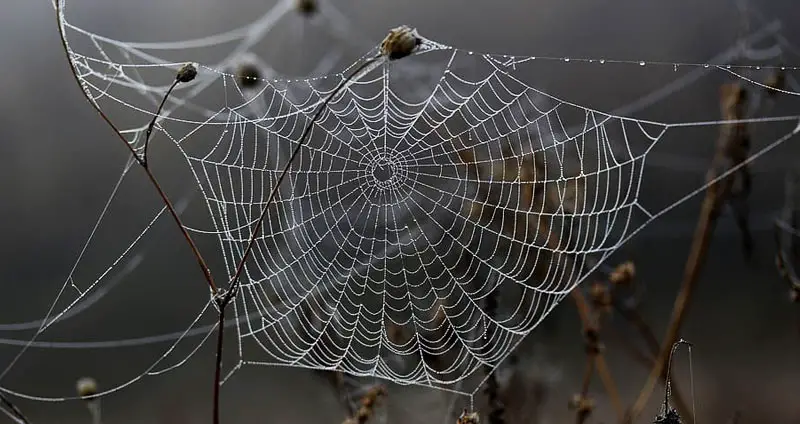
Description – This is an extremely common type of spider web, and one that most people think of when they picture a spider web. It’s estimated that these webs came to be around 100 million years ago when flying insects started to evolve.
This web is comprised of a very strong external frame that’s joined in the center to create spokes. These spokes are then joined together with a spiraling elastic thread to create a large surface area for capturing prey.
Some orb webs have additional designs outside of the standard spokes and spirals, but their purpose is unknown. It’s inferred that these flourishes are either used to better disguise the web, attract prey, or both.
How it works – The main frame of this web, the outer border and inner spokes, is constructed with elastic, sticky thread and droplets that are used to capture prey with ease.
These webs are constructed vertically in areas that get significant flying insect traffic. The most effective webs can capture upwards of 250 insects per day!
Spiders – These webs are primarily associated with the family Araneidae, or orb-weaver spiders. These spiders are primarily found outside, and many genus and species within it are non-threatening in terms of their venom.
2. Tangle Web / Cobweb
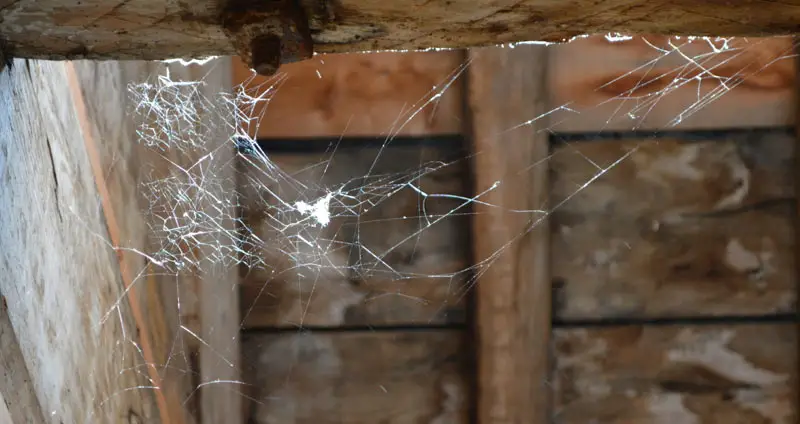
Description – Cobwebs are very commonly seen indoors in areas that don’t get much traffic, especially in corners. However, they’re not to be confused with collections of dust/dirt that can also be found in corners.
While they appear messy and disorganized, they’re actually created that way. They’re frequently anchored to the top of a structure and have many different threads hanging down off of it.
These webs commonly collect a lot of dust and dirt, adding to their dirty appearance.
How it works – The convoluted design of cobwebs is what makes them so effective. There are sticky droplets at the end of the dangling strings that sit right at floor level, acting as a snare.
When an insects walks across this thread and breaks it, it’s simultaneously stuck and lifted up into the web by the contracting thread. Once it reaches the web, it’s quickly subdued by the spider.
Spiders – Primarily made by spiders in the Theriidae family. This family includes very common and harmless house spiders, but it also includes very venomous spiders like the black widow.
3. Funnel Web
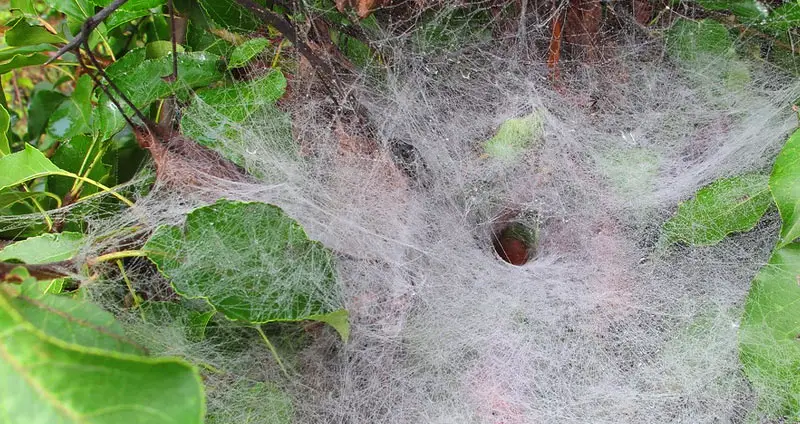
Description – The aptly-named funnel web is, as you could guess, shaped like a funnel. Expanses of thread span over a variety of distances, and they meet in the middle where they form a cylindrical hole.
This hole is where the funnel-weaver spider hides out and reaps some of the great benefits of this web design.
How it works – There are several interesting perks of this web design. First and foremost, it offers great protection for its creator, as the spider can hide in the difficult-to-access center.
Additionally, it’s the perfect ambush structure. Insects walk across the mat-like web, get tangled up, and are then subdued by the spider that quickly rushes out of its hole when it senses vibration.
Spiders – Agelenidae spiders, or funnel-weaver spiders, construct these webs. This isn’t to be confused with funnel-web spiders — creatures that are considered some of the most dangerous spiders in existence!
Many Agelenidae spiders are entirely harmless, such as the common Grass Spider. They also tend to be very fast and agile so that they can quickly subdue their tangled prey. They’re also quite photosensitive.
4. Sheet Web
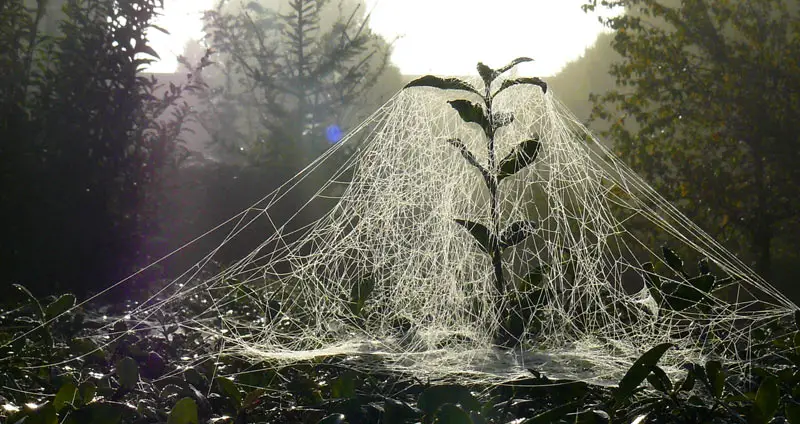
Description – These interesting webs take the classic web design and turn it horizontally. You can find these hammock-like webs draped over grass, bushes, or other structures.
Some of these webs lay very flat over grass, while others are dome-shaped.
How it works – The spiders that construct these webs simply hang upside-down from them and wait to ambush any insects that walk below. Flying insects often hit the threads and fall down to the spider.
While these webs are frequently damaged, they tend to be permanent structures unlike most other spider webs. Any damage is quickly patched up before it gets too bad.
Spiders – This type of web is associated with the Linyphiidae family. This is the second largest family of spiders and contains extremely small species with most posing no threat to humans.
5. Triangle Web
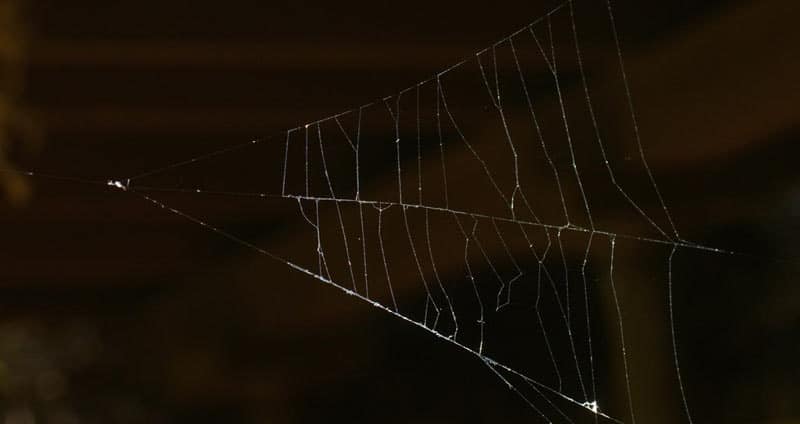
Description – Triangle webs are, just as their name suggests, built in the shape of a triangle in a vertical fashion. There are typically four main anchor points, with one on one side and three on the other.
Three strands of silk are connected with thread to create a very simple web.
How it works – While these webs are unique in their design, they’re even more unique in their function. The thread used for these webs is fuzzy and actually entangles and smothers insects.
Spiders – The Uloboridae family of spiders is associated with this type of web. They use such an interesting hunting strategy because they’re the only family that doesn’t possess venom glands.
Thus, the smothering ability of the web makes up for the lack of an effective bite from these spiders.
That lack of venom also means that these spiders are not threatening in the least.
6. Mesh Web
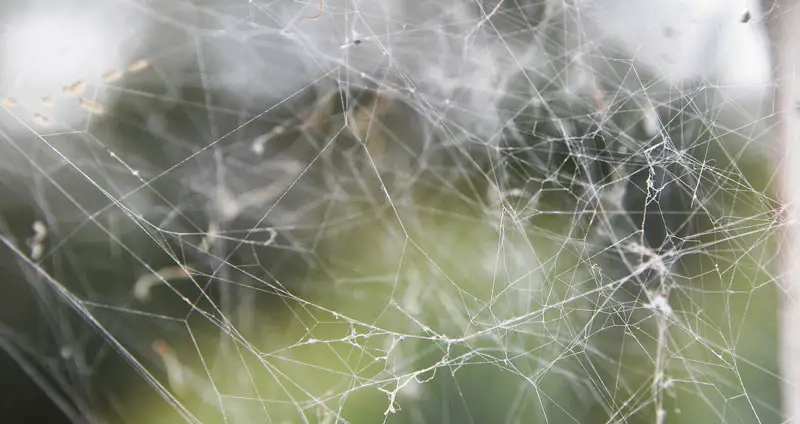
Description – Mesh webs are essentially cobwebs but located outside. They could actually be considered cobwebs, but they’re defined differently for clarity’s sake.
They aren’t entirely similar to cobwebs, though. Mesh webs are a bit more orderly in construction, and they’re often built under leaves and rocks or in grassy fields.
How it works – The function of these webs is very similar to cobwebs. They possess snare threads, and also work to entangle prey that touches the web.
Spiders – The Dictynidae family is responsible for mesh webs. This is a unique family of spiders that isn’t discussed much but possesses over 560 species.
3 Special Types Of Spider Webs
There are three additionally types of spider webs that serve unique purposes outside of housing and hunting.
Two of these three webs are primarily created by tarantulas, and they’re difficult to observe even in captivity. Therefore, it’s not likely you’ll come across these first two webs.
7. Sperm Web
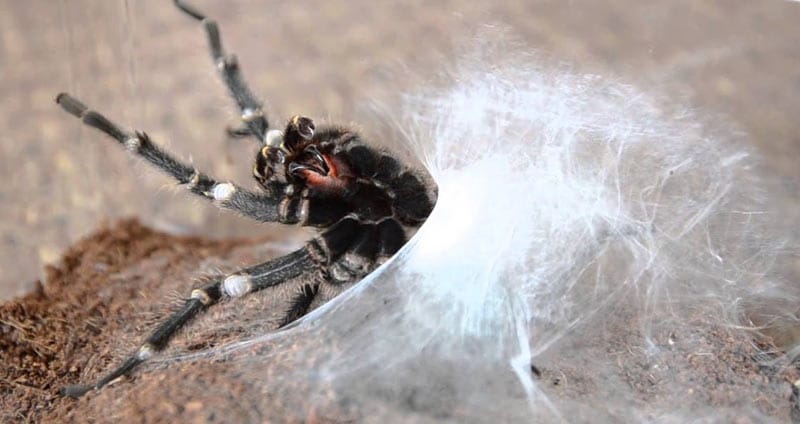
Description – Sperm webs are often small, tubular webs that are very easy to miss. They’re constructed very quickly and taken down and destroyed even faster as spiders are very secretive of these webs.
How it works – These webs are created by mature male spiders to transfer sperm from the epiandrous fusillae to the palpal bulbs.
Essentially, they’re created right when a spider is preparing to mate.
Spiders – Most, if not all tarantulas create these sperm webs, along with some other spiders.
8. Molt Mat
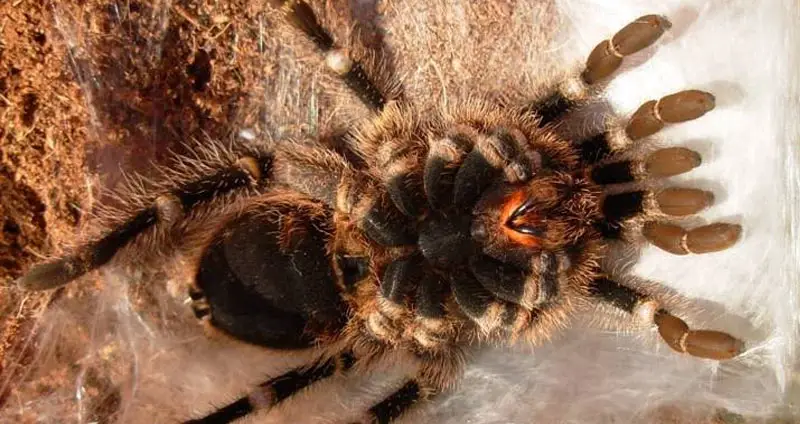
Description – This is predominantly a tarantula-made web. They’re thick mats of webbing that are laid out on the ground where a tarantula intends to flip over onto its back and begin molting.
Unlike sperm webs, these webs tend to be left after a molt is completed.
When a tarantula is constructing one of these mats, a molt will likely begin in the next few days.
How it works – Molt mats serve two main purposes for tarantulas. First and foremost, they provide a comfortable place for the tarantula to begin the uncomfortable process of molting. This is important as freshly-molted spiders are very fragile.
This mat also allows tarantulas to detect vibrations which will alert them if any predators are nearby.
Spiders – Tarantulas are the main spiders that utilize this type of webbing.
9. Egg Sac

Description – When spiders lay eggs, they lay quite a few at a time. Numbers of eggs range from two to 1,000. In order to contain all of these eggs, female spiders create an egg sac.
Egg sacs come in a variety of different shapes, ranging from discs to perfect spheres. They also range in color from white to dark brown to black.
They’re created by females that lay eggs on a silk mat, cover them with another silk mat, and then wrapping that all up in a ball.
How it works – Egg sacs are made of woven silk, and they work to both protect the spider eggs and keep them all together for easy transportation/storage/protection.
Once the spiderlings are ready to hatch, it’s very easy for them to escape from these loosely-woven egg sacs and start living their lives.
Spiders – Nearly all spiders create these egg sacs with very few exceptions.

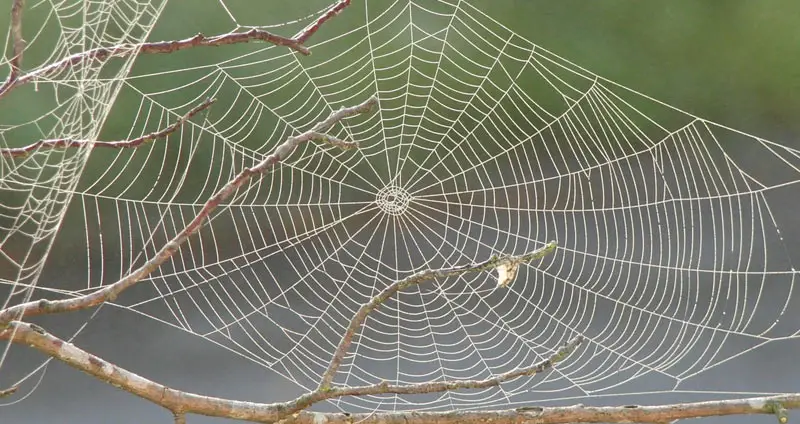
I have a spider in my yard that has created a beautiful web however the web has glowing in a different precise pattern that I thought at first was lightning bug .however the glow is not a bug but what looks like the spider has created the Web .is it possible that its a new species. I have lived in Delaware all my life.I looked it up but there is no information on this .it is scary but awesome
I have seen this spider for three nights in different areas of my table on the patio. It is so strange because he is gone in the morning when I woke up, but this morning he was there in his web. I went and got a cup of coffee came back to see him, he and his web was gone, it wasn’t five minutes. I looked every where for that spider, I couldn’t believe he and his web could disappear so quick. I’ll see tonight, we will see what happens.
I had an orb weaver outside my kitchen window for 2 days. She left before the 3rd night. Web was gone, too.